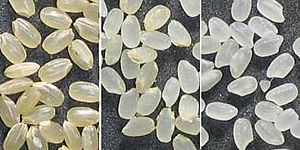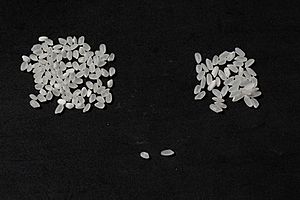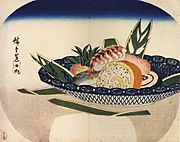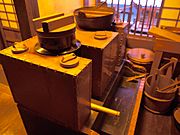Japanese rice facts for kids
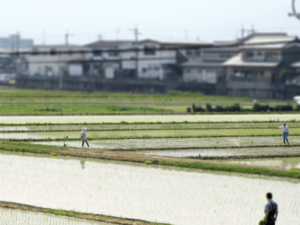
Japanese rice is a special type of short-grain rice grown in Japan. It includes two main kinds: ordinary rice, called uruchimai, and sticky rice, called mochigome.
Ordinary Japanese rice, uruchimai, is the most common type. It has small, clear grains. When cooked, it becomes sticky, which makes it easy to pick up with chopsticks. Outside Japan, you might see it called "sushi rice" because it's used a lot for sushi. It's also used to make sake, a Japanese alcoholic drink.
Glutinous rice, or mochigome, is even stickier when cooked. Its grains are shorter, rounder, and not clear. This rice is used to make mochi, which are chewy rice cakes, and other special dishes like sekihan.
Contents
Growing Japanese Rice
Growing rice in Japan uses a lot of machines and careful farming methods. Japan doesn't have a lot of flat land, so farmers often grow rice on hillsides in special steps called terraced fields. These fields are usually small.
Types of Japanese Rice
There are many different types, or "cultivars," of Japanese rice.
Popular Rice Varieties
Koshihikari is a very popular and highly valued type of rice. It's one of the most common kinds grown in Japan. Akitakomachi is another well-liked variety. Sasanishiki rice is known for tasting good even after it cools down. For making sake, the most famous type of rice is Yamada Nishiki.
In Hokkaidō, the northern part of Japan, farmers grow tougher types like Oborozuki and Yumepirika. These can handle the colder weather better.
Calrose Rice
Calrose rice is a medium-grain rice first grown in California, USA. Even though it's not from Japan, Japanese American farmers have grown it for many years. It's often used for Japanese food in North America and works well for sushi. Some Calrose rice is sent to Japan, but it's not as popular there. Now, even Koshihikari rice is grown in the US and Australia.
How Rice is Processed
Rice starts as brown rice, called genmai. This is the whole grain with its outer layers.
From Brown to White Rice
Most rice in Japan is processed into white rice, called hakumai. Machines polish the brown rice to remove the outer layers. White rice is the main food in Japan. Brown rice is also eaten, often because it's healthy, but it's less common.
Special Rice Types
Hatsuga genmai is brown rice that has been soaked in warm water until it starts to sprout. It's also known as GABA rice because this process increases a healthy substance called gamma-Aminobutyric acid. It's softer than regular brown rice and smells nice. You can buy it in stores or even make it at home.
Haigamai is rice that's partly milled. Most of the outer layer is removed, but the "germ" (the part that sprouts) is left. It cooks faster than brown rice and has more vitamins than white rice.
Rice Polishing Machines
In rural Japan, you can often find coin-operated machines called seimaijo where people can polish their own brown rice. It usually costs about 100 yen to polish 10 kilograms of rice. The leftover outer layers, called rice bran (komenuka), are used to make rice bran oil, a type of pickle called nukazuke, or even animal feed.
Most supermarkets in Japan sell white rice in bags of different sizes. Brown rice is often sold in larger bags, meant for people to polish themselves, or in smaller bags for eating as brown rice.
No-Wash Rice
Musenmai, or "no-wash rice," is white rice that has been specially processed. It doesn't need to be rinsed before cooking. This is good because the water used to rinse rice can cause water pollution in Japan.
How Japanese Rice is Used
Ordinary rice, uruchimai, is eaten in many ways in Japan.
Everyday Meals
Most often, it's served as plain cooked rice, called gohan. It's usually part of a typical Japanese meal with other dishes, pickles, and miso soup. In bento boxes (lunch boxes), it might have furikake (a seasoning), a pickled plum (umeboshi), or a sheet of nori (seaweed) on top. It's also used to make sushi and onigiri (rice balls).
For breakfast, people might mix plain rice with a raw egg and soy sauce, called tamago kake gohan, or with nattō (fermented soybeans). Plain rice is also used in Western-style Japanese dishes like curry rice and omurice (omelet rice). Leftover rice is often made into ochazuke (rice with green tea) or chāhan.
Takikomi gohan is another dish where ordinary rice is cooked with vegetables, meat, or fish, seasoned with broth and soy sauce.
Drinks and Other Products
Uruchimai is also used to make alcoholic drinks like sake and sometimes shochu. It can be an ingredient in Japanese beer and is used to make rice vinegar.
Uncooked brown rice grains are sometimes mixed with green tea leaves to make a tea called Genmaicha (brown rice tea).
Uses for Glutinous Rice
Glutinous rice, mochigome, is used for making mochi (chewy rice cakes). It's also in the festive red bean and rice dish sekihan, and traditional snacks like senbei (rice crackers) and arare.
Cooking Japanese Rice
Most Japanese people use special rice cookers, called suihanki, to cook rice.
First, the rice is washed to remove extra starch. Then, it's usually soaked in water for about 30 minutes in summer or up to two hours in winter. The soaking time depends on how fresh the rice is. After soaking, the rice is boiled with water, usually about five parts water to four parts rice. For very fresh rice, it can be a 1-to-1 ratio. Then, it's steamed until it's soft. Salt is not added to the rice.
Many modern rice cookers have timers, so you can set the rice to be ready when you wake up. They can also keep the rice warm and moist for several hours after it's cooked.
Cooked rice is usually served from the rice cooker into a small bowl called a chawan. Sometimes, it's kept in a covered wooden box called an ohitsu.
Trading Rice
The Dojima Rice Market in Osaka, Japan, was one of the first places in the world where people traded contracts for future rice delivery, starting around 1730. This market stopped in 1939.
Today, Japan wants to grow most of its own rice to support local farmers. Because of this, the Japanese government has rules and taxes on foreign rice. So, most rice eaten in Japan is grown right there. However, as rice prices have gone up, some Japanese people and restaurants are starting to buy smaller amounts of cheaper rice from places like China, Australia, and the United States.
See also
 In Spanish: Arroz japonés para niños
In Spanish: Arroz japonés para niños


